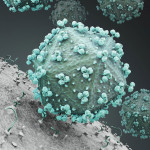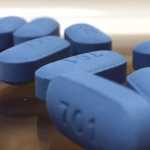 |
| Part of Seeing Me: Profiles of Resistance by Smith Galtney |
Seeing Me: Profiles of Resilience is a collection of portraits of individuals who have been impacted by HIV/AIDS in some way, both HIV-positive and negative, taken by Smith Galtney and first exhibited at the Salt Institute for Documentary Studies last year for World AIDS Day. Those photographed included long-term survivors and newly diagnosed, advocates, private funders, case managers and physicians, all with a different perspective and story. The exhibit is currently on view at Biddeford City Theater/City Hall from June 26 to August 22, coinciding with Pride Portland, southern Maine’s collection of Pride events. Below, Visual AIDS interviewed Smith about the photography and exhibition process.
Describe the Profiles of Resilience exhibition: its initial conception, the scope of the show, the range of sitters.
Back in August, I was asked by the Frannie Peabody Center in Portland, Maine to do a series of portraits involving Maine’s HIV/AIDS community. The year before, Frannie had mounted a show at the Salt Institute for Documentary Studies that detailed Maine’s history with HIV/AIDS. It incorporated a lot of archival material, and for the new show, they wanted to focus on the present. So they handed me a list of people to get in touch with - medical providers, advocates, people who were HIV positive, others who’d been affected by HIV in one form or another. We ended up spotlighting 24 individuals.
What was your process, perspective and vision as you photographed the portraits for Portraits of Resilience?
When I was first approached, I was really nervous because it felt like a huge responsibility. I’d tell friends about it and they’d immediately get this very serious look on their face. I made a point of meeting all the subjects beforehand, when that was possible, just to talk and get to know them a little first. Obviously all of their stories had parts that were intense and sobering, but none of them were depressing. And when the time came to take pictures, everybody was a lot of fun. The first few shoots had a magazine feel to them, casual and colorful, which seem like a good idea to run with. I think everybody’s seen the gritty, black-and-white side of the HIV/AIDS experience.
You’ve said you “didn’t want to put the person on a pedestal or under a microscope.” Can you describe what you mean by this, and how your photographs address the complexities of stigma surrounding those deeply impacted by HIV/AIDS?
Like I said, the first time I mentioned the show to people, a common reaction was to make a face, like “oh those poor people.” To go from that to actually meeting these so-called “poor” individuals, who didn’t seem poor in any way, was impressive. You can’t do a show like this without casting everyone in a heroic light, but we didn’t want to be too sentimental about it, which can feel cheap and condescending. And from the very start, I knew it was not my place to pry. At times I was tempted to ask someone how they got HIV or, in some cases, if they had it, but that seemed beside the point. The show wasn’t about being positive or negative. It wasn’t a PSA. It was about a collective experience.
Can you share any particularly moving anecdotes about the Profiles of Resilience photographing or exhibition process?
There was one day when I cracked. All of the portraits happened really quickly, within just a month, and there was one week where I was meeting up to three people a day. One afternoon, I met two older men who I related to immensely. They were gay like me. One had a very sick partner who had transitioned due to AIDS only four years ago, which I didn’t think happened anymore. The other was going through life stuff, tough financial problems, etc. I called my partner on the drive home and started crying. I think what made me sad had more to do with growing older than with HIV/AIDS, to be honest.
Each portrait was accompanied in the exhibition with a one paragraph first-person testimony from of the sitter sharing their story. What were some of the more charged or incisive responses highlighted in these text panels?
One guy named Jimmy talked about pros and cons of living with HIV for 25 years. On the one hand, it helped him to live for now, be in the moment, spend his money on a motorbike and ride across the country. But it also robbed him of big-picture plans, like investing in an education and saving up for a house. Another woman named Sharon, who’d turned her life around after battling drug addiction, summed up the show better than we ever could have: “I don’t regret anything I’ve done. I don’t regret who I am. I won’t regret who I’m becoming.”
What has been the response to the exhibition in the local Maine community and beyond?
It got lots of attention in the local press, which was great and a little unexpected. The best thing I can say about it is that everyone who came to see the show seemed to linger on each photograph and took the time to read the panels. There weren’t many people who came in and did a quick lap and split. That’s all you can ever hope for with a photo exhibit.
Having spent two decades living in New York City, can you share your sense of the differences or similarities that people living with HIV face in an urban versus rural context?
We moved to a small town in Maine six years ago. I went to New York University in ’89, after growing up in New Orleans. I told my mom I wanted to to there because it was the Harvard of film schools, but I really wanted to go there to be gay. Living in New York City was fabulous, of course, and it will always be my favorite city on Earth. I just didn’t realize what a bubble I’d been living in--a gay life with gay friends, just gayness everywhere! Since moving to Maine, my life has gotten way more integrated. There’s lesbians and straight couples and old people and young people. And I’ve met more females with HIV than I ever had in my life. I’d say maybe people tend to be a little more secretive about it in a rural environment? But urban folks can be hush-hush, too. I do know that almost all of the people I know who’ve seroconverted recently live in urban areas.
Your self-portrait was the closing image in the Salt Institute exhibition. Can you talk about the process of including your own image in the exhibition, and how the placement of the image relates to the narrative that is being told through Profiles of Resilience?
Katie Rutherford, Frannie’s director of development, asked me to include a self-portrait. Her idea was to hang it at the very end of the show, so I could serve as a sort of proxy for the viewer, a way of saying, “We’re all part of this experience and now you are, too.” I took a self-portrait with me surrounded by all of these records I’d been given by a recording engineer who’d died back in 1996, to hopefully underline how the AIDS/HIV experience has been around long enough for everyone to know someone who’s been affected by it. One newspaper printed the photo under the headline “Show Highlights Mainers with HIV.” At first I freaked out a little, like, “Um, guys, I don’t actually have HIV.” But for me to make some big deal about being HIV negative seemed completely at odds with everything I’d experienced putting the show together. So I got over it.
Smith Galtney is a recent graduate from the General Studies program at the International Center of Photography in New York. He also studied photography at the Salt Institute for Documentary Studies. His writing has appeared in The New York Times, GQ, Rolling Stone and Time Out New York. He lives with his partner in Raymond, Maine. They married in August.







Comments
Comments